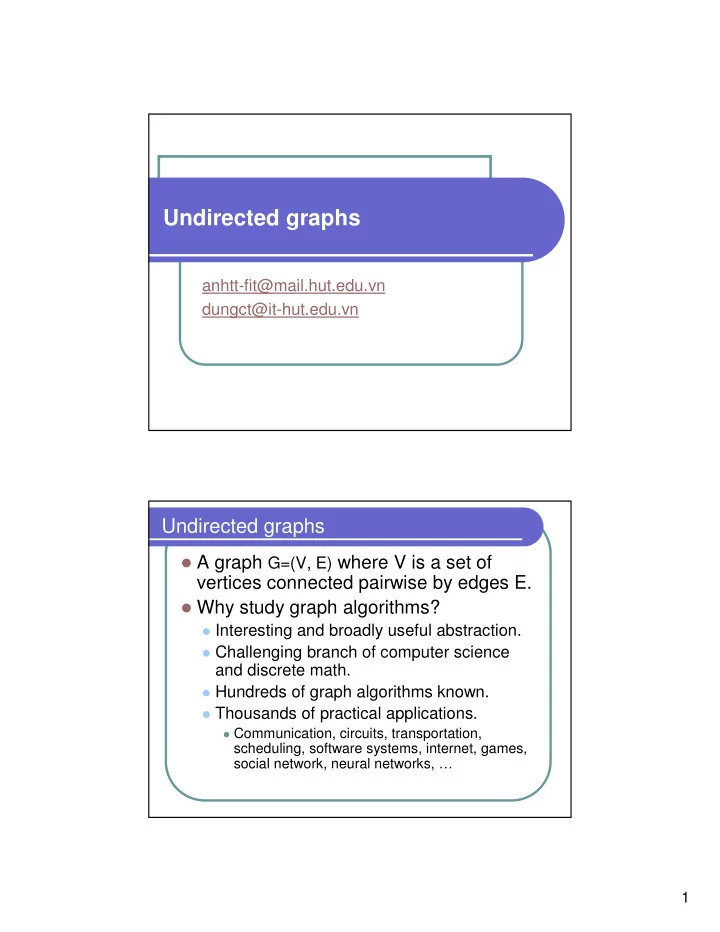

Undirected graphs anhtt-fit@mail.hut.edu.vn dungct@it-hut.edu.vn Undirected graphs � A graph G=(V, E) where V is a set of vertices connected pairwise by edges E. � Why study graph algorithms? � Interesting and broadly useful abstraction. � Challenging branch of computer science and discrete math. � Hundreds of graph algorithms known. � Thousands of practical applications. � Communication, circuits, transportation, scheduling, software systems, internet, games, social network, neural networks, … 1
Graph terminology Some graph-processing problems � Path: Is there a path between s to t? � Shortest path: What is the shortest path between s and t? � Cycle: Is there a cycle in the graph? � Euler tour: Is there a cycle that uses each edge exactly once? � Hamilton tour: Is there a cycle that uses each vertex exactly once? � Connectivity: Is there a way to connect all of the vertices? � MST: What is the best way to connect all of the vertices? � Biconnectivity: Is there a vertex whose removal disconnects the graph? 2
Graph representation (1) � Maintain a list of the edges � Not suitable for searching Edge List Structure � Edge sequence � sequence of edge objects � Edge object � element � origin vertex object � destination vertex object � reference to position in edge sequence � Vertex sequence � sequence of vertex objects � Vertex object � – element � – reference to position in vertex sequence 3
Graph representation (2) � Maintain an adjacency matrix. � Suitable for random accesses to the edges A graph data structure � Use a dynamic array to represent a graph as the following typedef struct { int * matrix; int sizemax; } Graph; � Define the following API Graph createGraph(int sizemax); void setEdge(Graph* graph, int v1, int v2); int connected(Graph* graph, int v1, int v2); int getConnectedVertices(Graph* graph, int vertex, int[] output); // return the number of connected vertices. 4
How to use the API? int i, n, output[100]; Graph g = createGraph(100); addEdge(g, 0, 1); addEdge(g, 0, 2); addEdge(g, 1, 2); addEdge(g, 1, 3); n = getAdjacentVertices (g, 1, output); if (n==0) printf("No adjacent vertices of node 1\n"); else { printf("Adjacent vertices of node 1:"); for (i=0; i<n; i++) printf("%5d", output[i]); } Quiz 1 � Write the implementation for the API defined in the previous slide � Use the example to test your API 5
Quiz 2 � In order to describe the metro lines of a city, we can store the data in a file as the following. [STATIONS] S1=Name of station 1 S2=Name of station 2 … [LINES] M1=S1 S2 S4 S3 S7 M2=S3 S5 S6 S8 S9 … � Make a program to read such a file and establish the network of metro stations in the memory using a two-dimensional array. � Write a function to find all the stations directly connected to a station given by its name. Graph representation (3) � Maintain an adjacency list. 6
Adjacency List Representation � A graph may also be represented by an adjacency list structure: 1 0 4 3 2 5 Array of linked lists, where list nodes store node labels for neighbors. Implementation � The red black tree can be used to store such a graph where each node in the tree is a vertex and its value is a set of connected vertices. � The set of connected vertices is stored in a red black tree it self. 7
Quiz 2 � Reuse the libfdr library to implement an API for manipulating the graph as the following typedef JRB Graph; Graph createGraph(); void setEdge(Graph* graph, int v1, int v2); int connected(Graph* graph, int v1, int v2); void forEachConnectedVertex(Graph* graph, int vertex, void (*func)(int, int) ); // the last one is a navigation function that iterates over all connected vertices of a given to do something. func is a pointer to the function that process on the connected vertices. � Rewrite the metro network program using this new API Comparison � Adjacency List is usually preferred, because it provides a compact way to represent sparse graphs – those for which |E| is much less than |V| 2 � Adjacency Matrix may be preferred when the graph is dense, or when we need to be able to tell quickly if their is an edge connecting two given vertices 8
Quiz 3 � Rewrite the API defined for graphs using the libfdr library as the following #include "jrb.h" typedef JRB Graph; Graph createGraph(); void addEdge(Graph graph, int v1, int v2); int adjacent(Graph graph, int v1, int v2); int getAdjacentVertices (Graph graph, int v, int* output); void dropGraph(Graph graph); Instructions (1) � To create a graph Simply call make_jrb() � To add a new edge (v1, v2) to graph g tree = make_jrb(); jrb_insert_int(g, v1, new_jval_v(tree)); jrb_insert_int(tree, v2, new_jval_i(1)); � If the node v1 is already allocated in the graph node = jrb_find_int(g, v1); tree = (JRB) jval_v(node->val); jrb_insert_int(tree, v2, new_jval_i(1)); 9
Instructions (2) � To get adjacent vertices of v in graph g node = jrb_find_int(g, v); tree = (JRB) jval_v(node->val); total = 0; jrb_traverse(node, tree) output[total++] = jval_i(node->key); � To delete/free a graph jrb_traverse(node, graph) jrb_free_tree( jval_v(node->val) ); Solution � graph_jrb.c 10
Homework � Redo the quiz 2 using the Graph library you have created in quiz 3 11
Recommend
More recommend